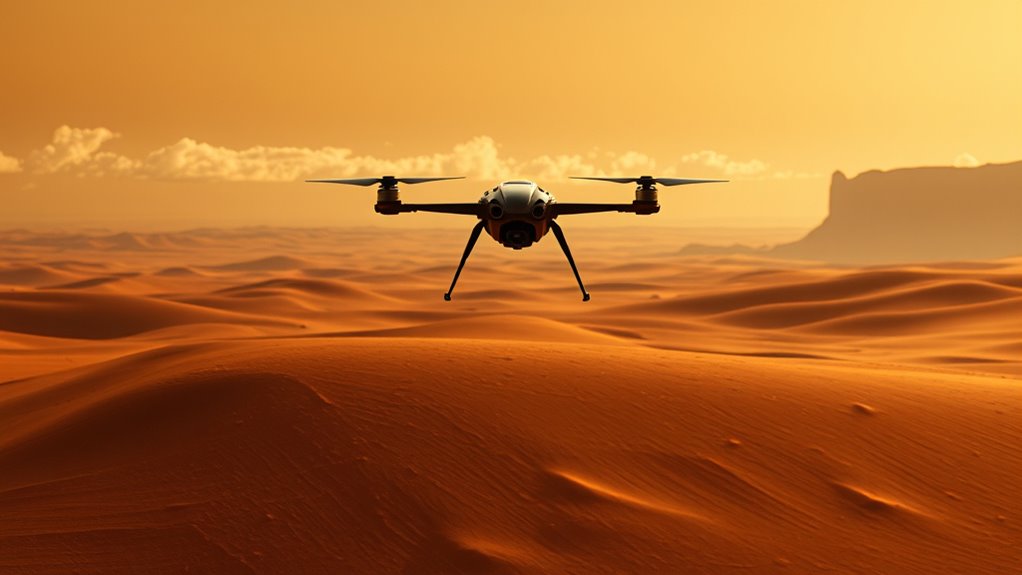NASA’s Dragonfly mission aims to explore Titan’s dunes and surface chemistry to find signs of prebiotic molecules and assess habitability. Using a rotorcraft designed for Titan’s low gravity and dense atmosphere, it will navigate diverse terrains, analyze organic compounds, and study surface materials with onboard sensors and drills. These discoveries could reveal important clues about complex organic chemistry and the potential for life, so keep exploring to learn more about this exciting mission.
Key Takeaways
- Dragonfly aims to explore Titan’s diverse dunes and surface terrains to analyze their composition and organic chemistry.
- The mission uses onboard drills and spectrometers to sample and identify organic molecules present in Titan’s dunes.
- Aerial mobility enables Dragonfly to access hard-to-reach dune fields and gather comprehensive surface data.
- Findings will provide insights into Titan’s prebiotic chemistry and potential habitability.
- The mission’s exploration enhances understanding of extraterrestrial organic processes and planetary geology.
The Goals Behind the Dragonfly Exploration
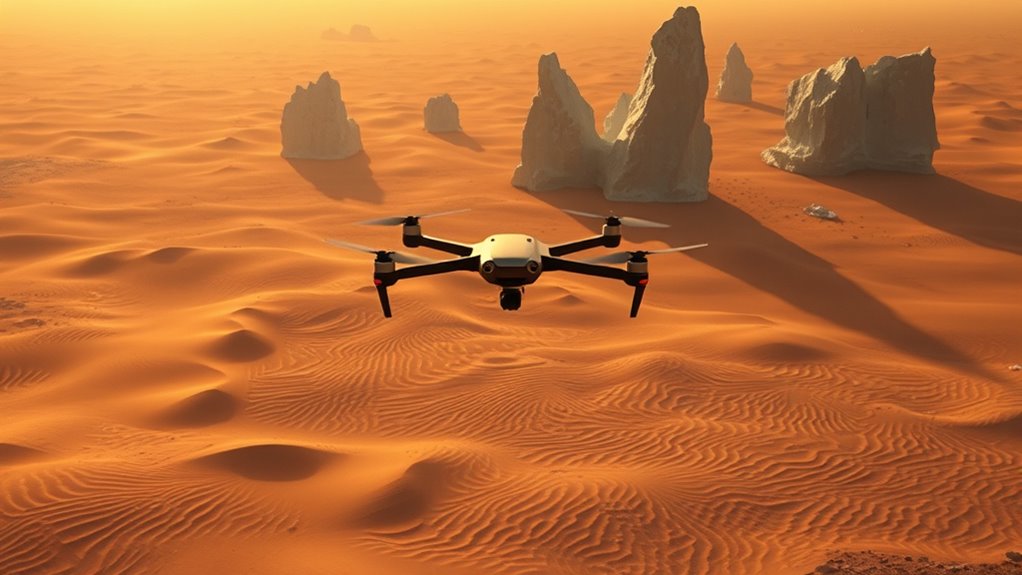
The primary goal of NASA’s Dragonfly mission is to explore Titan, Saturn’s largest moon, to determine if it has the necessary conditions to support life. You’ll see that this mission combines aerospace engineering and planetary science to achieve its objectives. By sending a rotorcraft, NASA aims to study Titan’s surface, chemistry, and atmospheric conditions directly, which helps scientists understand its potential habitability. The mission also seeks to gather data on organic molecules and liquid water reservoirs, critical for evaluating life’s building blocks. Through innovative aerospace engineering, Dragonfly will navigate Titan’s diverse terrains, providing insights that ground-based observations cannot offer. Additionally, the mission’s scientific instruments are designed to detect signs of past or present life and analyze organic chemistry in detail. Ultimately, your exploration efforts will deepen our understanding of planetary processes and the possibilities of life beyond Earth.
Designing a Rotorcraft for Alien Terrain

Designing a rotorcraft for Titan’s alien terrain presents unique engineering challenges that require innovative solutions. You must optimize rotorcraft aerodynamics to handle low gravity and dense atmosphere, ensuring stability and lift. To succeed, consider mission logistics, such as power sources and communication systems, which must operate reliably in harsh conditions. Key ideas include:
- Adjusting rotor blade design for high efficiency in Titan’s dense, nitrogen-rich atmosphere.
- Developing lightweight materials to maximize payload capacity while maintaining durability.
- Implementing autonomous navigation systems to adapt to unpredictable terrain and atmospheric conditions.
- Incorporating dynamic communication systems capable of maintaining data links despite Titan’s challenging environment.
Balancing rotorcraft aerodynamics with mission logistics ensures Dragonfly can explore Titan effectively, collecting data and steering through dunes despite its alien environment.
Key Instruments and Technologies Onboard
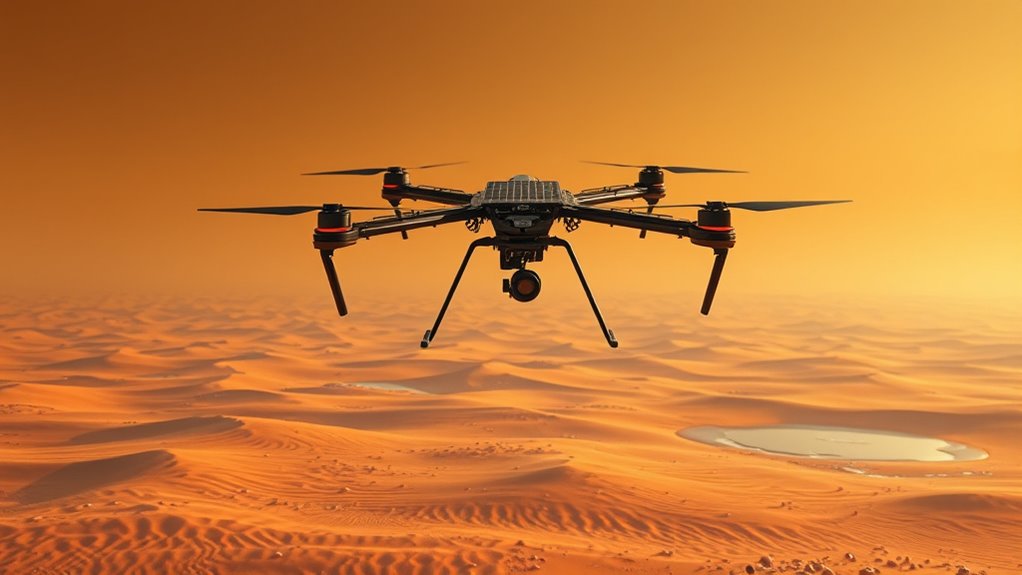
To explore Titan effectively, Dragonfly is equipped with a suite of advanced instruments and technologies tailored to its harsh environment. Its aerospace engineering guarantees durability and precision in extreme temperatures and thick atmosphere. The spacecraft carries instruments designed to analyze surface geology, including cameras, spectrometers, and a drill for collecting samples. These tools help identify mineral compositions and understand the planet’s geological history. A mass spectrometer will analyze organic molecules, providing insight into Titan’s chemistry. Additionally, onboard sensors measure atmospheric conditions, aiding navigation and scientific observations. This combination of cutting-edge instruments allows you to study Titan’s complex surface and environment directly, helping you unravel the processes shaping this intriguing world. The integration of aerospace engineering ensures the instruments work reliably in this alien landscape. Proper halal dietary practices are essential in supporting the well-being of the team operating these complex instruments, ensuring compliance and safety in the mission.
Navigating Titan’s Diverse Landscapes
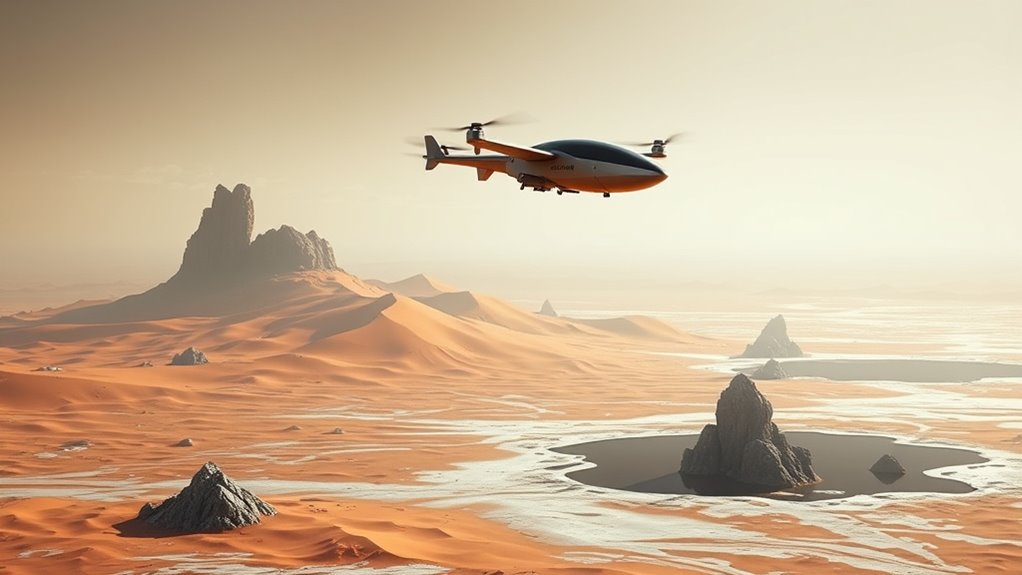
As you explore Titan’s surface, you’ll encounter a variety of terrain types that challenge navigation. The changing surface composition adds complexity, making each step unpredictable. These factors mean you’ll need to adapt quickly to the diverse landscapes ahead. Understanding the surface composition is essential for successful exploration and safety.
Diverse Terrain Types
Exploring Titan’s diverse landscapes presents a unique challenge for the Dragonfly mission. You’ll encounter a variety of terrain types, from vast dunes to icy plains, each shaped by complex atmospheric dynamics. Aerosol clouds drift across Titan’s sky, influencing surface features and weather patterns. To navigate this terrain effectively, consider these key points:
- Dune fields formed by wind-driven sediments reveal Titan’s atmospheric circulation.
- Icy plains showcase areas where surface composition varies, demanding adaptable exploration methods.
- Hilly regions and potential cryovolcanoes require precise movement to avoid hazards.
- Recognizing how aerosol clouds and atmospheric dynamics influence surface features can help you anticipate terrain changes and plan your routes, ensuring safe and efficient exploration across Titan’s multifaceted landscapes.
Navigational Challenges Ahead
Navigating Titan’s diverse landscapes poses significant challenges that require careful planning and adaptability. The terrain’s variability demands advanced aerospace engineering to develop robust guidance systems capable of handling unpredictable surfaces and obstacles. You’ll need precise sensors and mapping tools to avoid hazards like steep slopes or soft dunes, ensuring a safe journey. Communication with Earth also becomes more complex, as Titan’s thick atmosphere can interfere with extraterrestrial communication signals, causing delays or data loss. To succeed, you must rely on autonomous navigation and real-time decision-making. This combination of engineering ingenuity and adaptive strategies will be essential for Dragonfly to traverse Titan’s unpredictable terrain, explore its dunes, and gather valuable scientific data. Overcoming these hurdles is essential for the mission’s success. Additionally, understanding the diverse landscapes of Titan helps engineers design more effective exploration tools and strategies.
Surface Composition Variations
Titan’s surface presents a complex mosaic of materials that vary widely across different regions, demanding precise analysis for safe exploration. These variations stem from interactions between the subsurface ocean and atmospheric dynamics, shaping diverse landscapes. You’ll encounter icy plains, hydrocarbon lakes, and organic-rich dunes, each with distinct compositions. Understanding these differences helps predict terrain stability and resource distribution. Additionally, diverse beach experiences across Titan’s landscapes influence exploration strategies. Mapping these variations guides your navigation and sampling strategies, revealing Titan’s dynamic geology and climate history.
Sampling and Analyzing Surface Materials
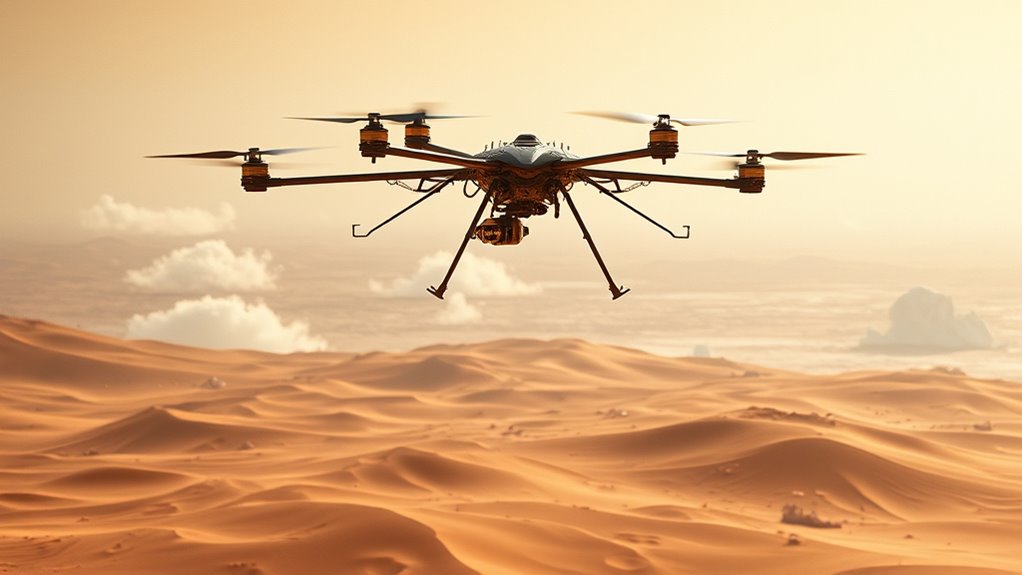
How will NASA’s Dragonfly mission collect and analyze surface materials on Titan? Using its aerial mobility, Dragonfly can fly across diverse terrains, reaching areas that rovers can’t access. It will perform surface mapping to identify promising sampling sites, such as dunes and organic-rich deposits. Once at a site, the drone’s instruments, including drills and scoops, will collect surface samples. These samples will be analyzed onboard with advanced instruments to determine their composition, mineralogy, and potential organic content. The combination of aerial mobility and surface mapping allows Dragonfly to target specific locations for sampling, ensuring a thorough understanding of Titan’s surface. This approach enables detailed analysis of the environment, paving the way for future discoveries about the moon’s geology and potential habitability. Techniques like surface analysis will help scientists interpret the data collected from Titan’s surface.
Investigating Organic Compounds and Prebiotic Chemistry
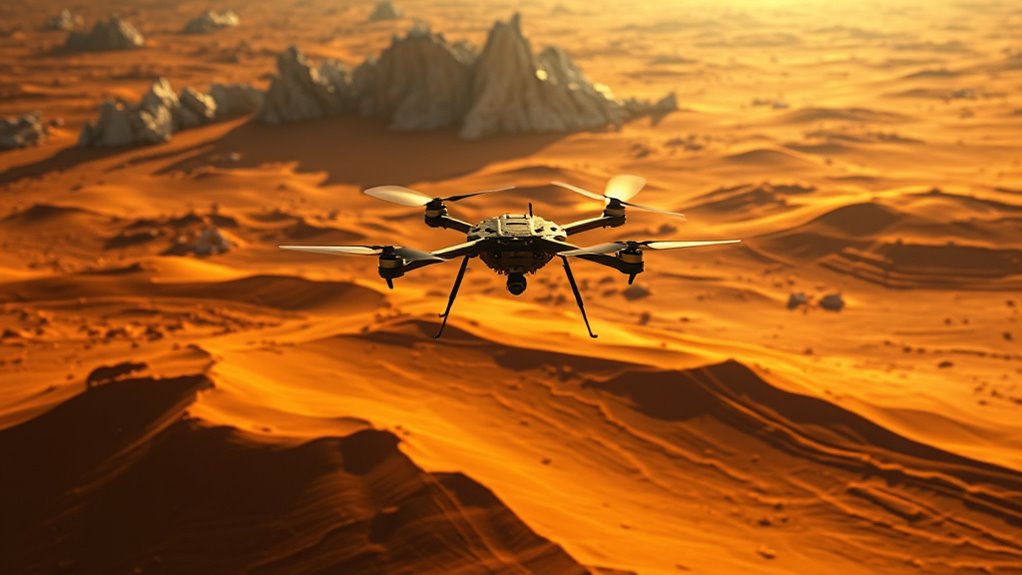
By analyzing surface samples, NASA’s Dragonfly mission aims to identify organic compounds and assess prebiotic chemistry on Titan. You’ll explore how aerosol chemistry contributes to complex organic molecules in the atmosphere, which can settle onto the surface. Atmospheric dynamics help transport these compounds, influencing their distribution across Titan’s dunes. This investigation involves examining:
- The composition of organic aerosols formed through atmospheric reactions
- The role of atmospheric dynamics in delivering organics to the surface
- Potential chemical pathways leading to prebiotic molecules on Titan
Understanding these processes reveals how complex organics form and evolve in Titan’s environment. Data analysis techniques support this research by enabling precise identification of organic molecules and tracking their distribution. Your findings could shed light on prebiotic chemistry, offering clues about the origins of life and chemical evolution beyond Earth. This research deepens our grasp of Titan’s organic chemistry and its potential habitability.
Potential Discoveries and Their Significance

The analysis of organic compounds and prebiotic chemistry on Titan could lead to groundbreaking discoveries about the moon’s potential for life. By studying aerosol formation, you might uncover how complex organic molecules originate and evolve in Titan’s thick atmosphere. This understanding can reveal the processes driving atmospheric dynamics, which influence surface chemistry and climate patterns. Such insights could identify chemical pathways that mirror early Earth conditions, hinting at the possibility of life or prebiotic activity. If you observe specific organic signatures or unusual aerosol behaviors, it might suggest active chemical cycles that support habitability. These findings could reshape our understanding of life’s potential beyond Earth, emphasizing Titan as a key target in the search for extraterrestrial life and expanding our knowledge of planetary atmospheres. Nutritional insights from terrestrial seeds like chia could also inspire models for how organic molecules might be stored or transported in extraterrestrial environments, providing a fascinating link between planetary science and astrobiology.
The Future of Planetary Exploration With Dragonfly

As NASA’s Dragonfly mission prepares to explore Titan’s diverse landscapes, it promises to revolutionize our understanding of planetary science and the potential for life beyond Earth. With its advanced aerial mobility, you’ll experience a new way to study planetary geology firsthand, flying across different terrains and accessing hard-to-reach areas. This drone-like rotorcraft will enable you to gather detailed data on Titan’s surface and subsurface, offering insights into its organic chemistry and habitability. The future of planetary exploration is bright, with Dragonfly leading the way toward more autonomous, versatile missions. Your exploration efforts could pave the path for:
- Expanding our knowledge of planetary geology through direct observation
- Developing new aerial mobility technologies for other celestial bodies
- Discovering signs of life or prebiotic chemistry on distant worlds
Frequently Asked Questions
How Will Dragonfly Communicate With Earth During Its Mission?
You might wonder how Dragonfly will talk to Earth during its mission. It’ll use radio communication to send and receive signals. Since Titan’s thick atmosphere can block direct signals, the spacecraft will rely on a signal relay system, probably involving a relay orbiter or the lander itself acting as a communication hub. This setup guarantees continuous contact, keeping you connected to the mission’s progress on Titan.
What Challenges Does Titan’s Thick Atmosphere Pose for the Drone?
Ever wonder how a drone handles such a thick atmosphere? Titan’s dense atmospheric density challenges your drone’s stabilization, making flight tricky. You need sophisticated sensors and propellers to counteract turbulence and maintain control. The thick air also impacts communication signals, requiring strong transmission systems. Can your drone adapt to these conditions to explore Titan’s mysterious dunes effectively? Overcoming these challenges is essential for successful exploration.
How Long Is Dragonfly Expected to Operate on Titan’s Surface?
You’re curious about how long Dragonfly will operate on Titan’s surface. The mission’s expected duration is about 2.7 years, which is the planned operational lifespan. During this time, you’ll see the drone explore Titan’s diverse environments, including its dunes and lakes. NASA designed Dragonfly to be durable, but its actual lifespan might vary due to environmental conditions and technical challenges. Overall, it’s an exciting mission with a significant mission duration.
Will Dragonfly Be Able to Analyze Subsurface Liquids or Ice?
Imagine holding a magnifying glass over a hidden world; that’s what Dragonfly aims to do with subsurface analysis and ice composition. It’s equipped with advanced instruments to probe beneath Titan’s surface, so you’ll be able to analyze subsurface liquids and ice. This mission could reveal whether life might exist in those hidden reservoirs, making it a vital step in understanding Titan’s mysterious environment.
How Does Dragonfly Compare to Previous Planetary Exploration Drones?
You’ll find that Dragonfly surpasses previous planetary drones with its advanced scientific instrumentation and aerial maneuvering capabilities. Unlike earlier missions, it can fly across Titan’s diverse terrain, analyzing samples and gathering data from multiple locations. Its ability to hover and navigate complex landscapes allows for in-depth scientific exploration, making it a groundbreaking mission that extends our reach and understanding far beyond what traditional robotic explorers could achieve.
Conclusion
With Dragonfly soaring across Titan’s alien dunes, you’re on the brink of uncovering secrets that could rewrite life’s story in the universe. Imagine discovering compounds that hold the keys to prebiotic chemistry, all while traversing landscapes more surreal than any dream. As you witness this incredible voyage, know that your curiosity is propelling humanity into an epoch where the mysteries of distant worlds become dazzling realities—truly a leap into the cosmos like never before.

